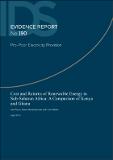| dc.contributor.author | Pueyo, Ana | |
| dc.contributor.author | Bawakyillenuo, S | |
| dc.contributor.author | Osiolo, H | |
| dc.coverage.spatial | Ghana | en |
| dc.coverage.spatial | Kenya | en |
| dc.date.accessioned | 2016-04-20T12:09:43Z | |
| dc.date.available | 2016-04-20T12:09:43Z | |
| dc.date.issued | 2016-04 | |
| dc.identifier.citation | Pueyo, A.; Bawakyillenuo, S. and Osiolo, H. (2016) Cost and Returns of Renewable Energy in Sub-Saharan Africa: A Comparison of Kenya and Ghana, IDS Evidence Report 190, Brighton: IDS | en |
| dc.identifier.uri | https://opendocs.ids.ac.uk/opendocs/handle/20.500.12413/11297 | |
| dc.description.abstract | The allocation of finance for the provision of green electricity in sub-Saharan Africa (SSA) should be informed by two questions. Which generation technologies are financially viable? And which generation technologies are affordable? Our analysis addresses these for Kenya and Ghana by calculating the levelised cost of energy (LCOE) and internal rate of return (IRR) for a portfolio of renewable energy (RE) technologies under different scenarios. Our results show better fundamentals in Kenya for the successful implementation of renewable energy projects. Wind and geothermal technology offer low-cost electricity and healthy returns on investment. Solar photovoltaics (PV) could be competitive with expensive diesel generation but its current price does not allow for cost recovery. Kenyan feed-in tariffs (FiTs) protect investors against currency devaluation and the off-taker is creditworthy. Ghana’s renewable electricity (except hydro) is expensive in comparison and offers lower returns. This is mainly due to high financing costs and lower-quality RE resources. Additionally, RE investors in Ghana are not protected against further currency devaluation by the existing FiT scheme and there are concerns about the creditworthiness of the off-taker. Policymakers should target these key constraints to affordability and profitability to support a higher penetration of renewables in the country. The role of public finance and public–private partnership is particularly highlighted as a way forward to improve the financial performance of renewable energy in SSA. | en |
| dc.description.sponsorship | UK Department for International Development; EPSRC | en |
| dc.language.iso | en | en |
| dc.publisher | IDS | en |
| dc.relation.ispartofseries | IDS Evidence Report;190 | |
| dc.rights.uri | http://creativecommons.org/licenses/by/3.0/ | en |
| dc.subject | Environment | en |
| dc.subject | Finance | en |
| dc.subject | Technology | en |
| dc.title | Cost and Returns of Renewable Energy in Sub-Saharan Africa: A Comparison of Kenya and Ghana | en |
| dc.type | IDS Evidence Report | en |
| dc.rights.holder | IDS | en |
| dc.identifier.ag | OT/11009/4/1/4/584 | |


